
"Omnilingual" is a science fiction short story by American writer H. Beam Piper. [1] Originally published in the February 1957 issue of Astounding Science Fiction , [2] it focuses on the problem of archaeology on an alien culture. [3]

"Omnilingual" is a science fiction short story by American writer H. Beam Piper. [1] Originally published in the February 1957 issue of Astounding Science Fiction , [2] it focuses on the problem of archaeology on an alien culture. [3]
An expedition from Earth to Mars discovers a deserted city, the remains of an advanced civilization that died out 50,000 years before. The human scientists recover books and documents left behind, and are puzzled by their contents. Earnest young archeologist Martha Dane deciphers a few words, but the real breakthrough comes when the team explores what appears to have been a university in which the last few civilized Martians made their last stand. Inside, they find a "Rosetta Stone": the periodic table of the elements. The story builds tension from the skepticism of the rest of the team, mostly male, as well as from Dr. Dane's competitive, spotlight-seeking teammate, Tony Lattimer.
Jo Walton stated that Omnilingual was "influential" and "the classic SF short story, the one everyone ought to read if they’re only going to read one", and noted that the story "raises a question that everyone who has dealt with the subject [when writing science fiction] since has had to either accept or find a way around", namely "If scientific truths are true for everyone, will we therefore be able to communicate with all scientifically literate cultures using science?" Walton also commended the story's use of gender equality and multicultural characters, with "the only thing that made [her] raise [her] eyebrows" being the constant use of alcohol and tobacco. [2] it focuses on the problem of archaeology on an alien culture. [3]
James Nicoll questioned the basic premise of scientific language being necessarily decipherable — "what if Martian didn't use letters and a numbering system which sounds very akin to ours?" — but overall concluded that the story was "well worth reading." [4] The Routledge Companion to Science Fiction similarly faulted this "ideological sleight-of-hand", emphasizing that the "extinct Martian civilization closely resembles the [then-]contemporary US: language is recorded in a linear written form divided into words; the title pages of printed magazines feature the title, month of publication, issue number, and table of contents; Martians live in cities with universities; universities are divided into disciplinary departments — and classrooms — more or less identical to terrestrial ones; and on the wall of the material sciences lab hangs a periodic table of elements, organizing information which might apply universally but which in no way demands graphic representation or public display." [5]
John W. Cowan, inventor of Lojban, praised Omnilingual as "one of the best, science fiction stories in which the science is linguistic archaeology", and published a modernized version to his website in 2009. [6]
In 2018, Tomi S. Melka and Michal Místecký carried out a complex quantitative analysis of the novelette's style. [7]
Omnilingual has been reprinted several times since its original publication.

Isaac Asimov was an American writer and professor of biochemistry at Boston University. During his lifetime, Asimov was considered one of the "Big Three" science fiction writers, along with Robert A. Heinlein and Arthur C. Clarke. A prolific writer, he wrote or edited more than 500 books. He also wrote an estimated 90,000 letters and postcards. Best known for his hard science fiction, Asimov also wrote mysteries and fantasy, as well as much nonfiction.

Mars, the fourth planet from the Sun, has appeared as a setting in works of fiction since at least the mid-1600s. Trends in the planet's portrayal have largely been influenced by advances in planetary science. It became the most popular celestial object in fiction in the late 1800s as the Moon was evidently lifeless. At the time, the predominant genre depicting Mars was utopian fiction. Contemporaneously, the mistaken belief that there are canals on Mars emerged and made its way into fiction, popularized by Percival Lowell's speculations of an ancient civilization having constructed them. The War of the Worlds, H. G. Wells' story of an alien invasion of Earth by sinister Martians, was published in 1897 and went on to have a large influence on the science fiction genre.
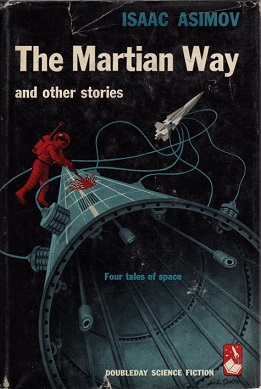
The Martian Way and Other Stories is a 1955 collection of four science fiction stories (3 novelettes and one novella by American writer Isaac Asimov, previously published in 1952 and 1954. Although single-author story collections generally sell poorly, The Martian Way and Other Stories did well enough that Doubleday science fiction editor Walter I. Bradbury was willing to publish a second collection, Earth Is Room Enough, in 1957.

Henry Beam Piper was an American science fiction writer. He wrote many short stories and several novels. He is best known for his extensive Terro-Human Future History series of stories and a shorter series of "Paratime" alternate history tales.

Stanley Grauman Weinbaum was an American science fiction writer. His first story, "A Martian Odyssey", was published to great acclaim in July 1934; the alien Tweel was arguably the first character to satisfy John W. Campbell's challenge: "Write me a creature who thinks as well as a man, or better than a man, but not like a man." Weinbaum wrote more short stories and a few novels, but died from lung cancer less than a year and a half later.
Xenoarchaeology, a branch of xenology dealing with extraterrestrial cultures, is a hypothetical form of archaeology that exists mainly in works of science fiction. The field is concerned with the study of the material remains to reconstruct and interpret past life-ways of alien civilizations. Xenoarchaeology is not currently practiced by mainstream archaeologists due to the current lack of any material for the discipline to study.
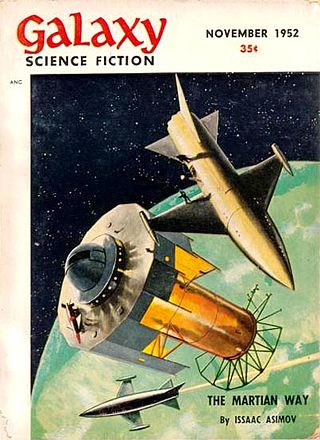
The Martian Way is a science fiction novella by American writer Isaac Asimov. It was first published in the November 1952 issue of Galaxy Science Fiction and reprinted in the collections The Martian Way and Other Stories (1955), The Best of Isaac Asimov (1973), and Robot Dreams (1986). It was also included in The Science Fiction Hall of Fame, Volume Two (1973) after being voted one of the best novellas up to 1965.
The first Golden Age of Science Fiction, often recognized in the United States as the period from 1938 to 1946, was an era during which the science fiction genre gained wide public attention and many classic science fiction stories were published. In the history of science fiction, the Golden Age follows the "pulp era" of the 1920s and 1930s, and precedes New Wave science fiction of the 1960s and 1970s. The 1950s are a transitional period in this scheme; however, Robert Silverberg, who came of age in the 1950s, saw that decade as the true Golden Age.

"A Martian Odyssey" is a science fiction short story by American writer Stanley G. Weinbaum originally published in the July 1934 issue of Wonder Stories. It was Weinbaum's second published story, and remains his best known. It was followed four months later by a sequel, "Valley of Dreams". These are the only stories by Weinbaum set on Mars.
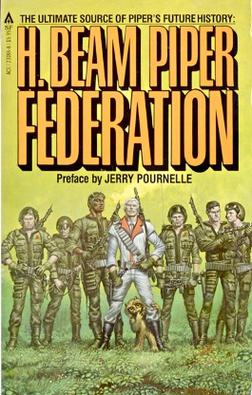
Federation is a collection of short stories by American writer H. Beam Piper, edited by John F. Carr. The book was published in 1981 by Ace Books, and again in 1982, 1983 and 1986. Most of these stories take place in the early part of his Terro-Human Future History.
"Half-Breed" is a science fiction short story by American writer Isaac Asimov. It was first published in the February 1940 issue of Astonishing Stories and reprinted in the 1972 collection The Early Asimov. It was the fifteenth story written by Asimov, and the fourth to be published. At 9000 words, it was his longest published story to date.

"The Secret Sense" is a science fiction short story by American writer Isaac Asimov published in Cosmic Stories in March 1941. It takes place against the background of an ancient and highly developed culture living in large underground cities on Mars.

Great Science Fiction Stories About Mars is a 1966 anthology of science fiction short stories edited by T. E. Dikty and published by Fredrick Fell. Most of the stories had originally appeared in the magazines Startling Stories, Argosy, Thrilling Wonder Stories, Amazing Stories, Super Science Stories and Astounding SF.

In the Courts of the Crimson Kings is a 2008 alternate history science fiction novel by American writer S. M. Stirling.

Isaac Asimov Presents The Great SF Stories 9 (1947) is a science fiction anthology edited by Isaac Asimov and Martin H. Greenberg. It is the ninth volume of Isaac Asimov Presents The Great SF Stories, a series of short story collections, which attempts to list the great science fiction stories from the Golden Age of Science Fiction. They date the Golden Age as beginning in 1939 and lasting until 1963. The book was later reprinted as the first half of Isaac Asimov Presents The Golden Years of Science Fiction, Fifth Series with the second half being Isaac Asimov Presents The Great SF Stories 10 (1948). This volume was originally published by DAW books in February 1983.
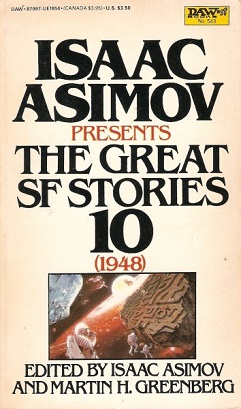
Isaac Asimov Presents The Great SF Stories 10 (1948) is the tenth volume of Isaac Asimov Presents The Great SF Stories, which is a series of short story collections, edited by Isaac Asimov and Martin H. Greenberg, which attempts to list the great science fiction stories from the Golden Age of Science Fiction. They date the Golden Age as beginning in 1939 and lasting until 1963. The book was later reprinted as the second half of Isaac Asimov Presents The Golden Years of Science Fiction, Fifth Series with the first half being Isaac Asimov Presents The Great SF Stories 9 (1947). This volume was originally published by DAW books in August 1983.

The War of the Worlds is a science fiction novel by English author H. G. Wells, written between 1895 and 1897, first serialised in 1897 by Pearson's Magazine in the UK and by Cosmopolitan magazine in the US. The novel's first appearance in hardcover was in 1898 from publisher William Heinemann of London. It is one of the earliest stories to detail a conflict between mankind and an extra-terrestrial race. The novel is the first-person narrative of both an unnamed protagonist in Surrey and of his younger brother in London as southern England is invaded by Martians. The novel is one of the most commented-on works in the science fiction canon.
"The Weapon" is a short story by the American science fiction writer Isaac Asimov. Written in September 1938 when Asimov was 18, it was first published in the May 1942 issue of Super Science Stories under a pseudonym, H.B. Ogden. Because of the pseudonym, Asimov forgot that this story had ever been published and so, assuming that it had been rejected and believing that he no longer had a copy of it, he omitted it from The Early Asimov (1972), a collection of his earliest stories. In that book he listed "The Weapon" among eleven of his short stories that had been lost forever. However, while writing the first volume of his autobiography, In Memory Yet Green (1979), Asimov came across an entry in his diary which reminded him that the story had indeed been published. Obtaining a copy of the relevant magazine, he ensured that the story was published in chapter 30 of that book.
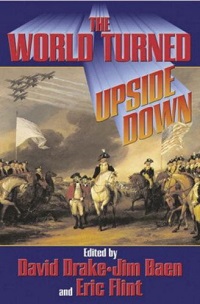
The World Turned Upside Down is an anthology of science fiction and fantasy short stories edited by David Drake, Eric Flint and Jim Baen. It was first published in hardcover and ebook by Baen Books in January 2005; a Science Fiction Book Club edition followed from Baen Books/SFBC in February of the same year. The first paperback edition was issued by Baen in June 2006.